Time Sheet in Excel: A step-by-step guide and Free Templates
Tracking employee time in an Excel spreadsheet isn’t the easiest way to keep track of hours for payroll. For that, you might check out automated time tracking that integrates seamlessly with your payroll solution. But if you’re still shopping around and wondering if spreadsheets are right for you, download one of our free timesheet templates from below or learn how to make a timesheet in Excel. What follows is a step-by-step guide to creating a timesheet in Excel and some ready to download templates for you to use in your business.
How to create an Excel timesheet
Every business has different needs. They depend on the type of work that business does, how many people it employs, and about a hundred other variables. That’s why the first step to making a timesheet in Excel is to identify the categories you’ll need to create to run payroll—and your business—successfully. This timesheet includes space for employees to write down the following for each week.
- The date
- The job or shift
- The start time employees clock in (before and after lunch)
- The times employees clock out (before and after lunch)
- Their total number of hours
- They total number of overtime hours
- Their total number of sick hours
- Their total number of holiday hours
- Their total number of holiday hours
Pros & Cons of Using A Timesheet Template
Pro: Automation
Timesheets can make a lot of your processes more efficient via automation. With a timesheet template, you don’t need to manually work out the number of hours that a team member worked in a particular month. Automation therefore gives other employees like those in your HR and payroll departments more time to focus on other tasks.
Pro: Lower costs due to accurate invoicing
Timesheets make it easier to track invoicing, especially when you’re operating as an agency or if you’re outsourcing some of your work to another agency. Having a timesheet template makes for more accurate invoicing which subequently results in correct payments to your employees and ultimately lower costs due to fewer errors made.
Pro: Better tracking of employee behaviour
Using a timesheet template makes it simpler to identify which departments are clocking more hours, meaning you can also better identify which departments need an extra helping hand. You can also use timesheet templates to better understand which employees regularly clock out early and how to streamline their activity while they’re at work.
Con: Extra work for your employees
Although your payroll and HR departments will love timesheets because of how much time it saves them from performing manual processes, timesheets also create extra work for others. Whereas employees were previously having their hours tracked without their input, they now need to remember to use a timesheet template before their week is over.
Con: Human error
Timesheets rely on human interaction, meaning that using a timesheet template introduces a greater risk of human error. This human error may be accidental – mistakes are only happen, after all – but you may also run the risk of someone manipulating their hours on purpose.
Your timesheet might also include columns for answers to yes or no questions (e.g., Were you injured on the job? Is the project complete?) or space for client signatures.
Once you know which columns or labels you want in your timesheet, it’s time to create the working product. Here’s how to create a simple timesheet template any employee can use.
Step 1: Format your spreadsheet
To create a spreadsheet that’s easy to read, first you need to format. Make all your cells wider, by first widening cell A (ours is set to 14.83). Then right-click on column A, select Copy, highlight columns B through L, right-click again, and select Paste Special, then Formatting.
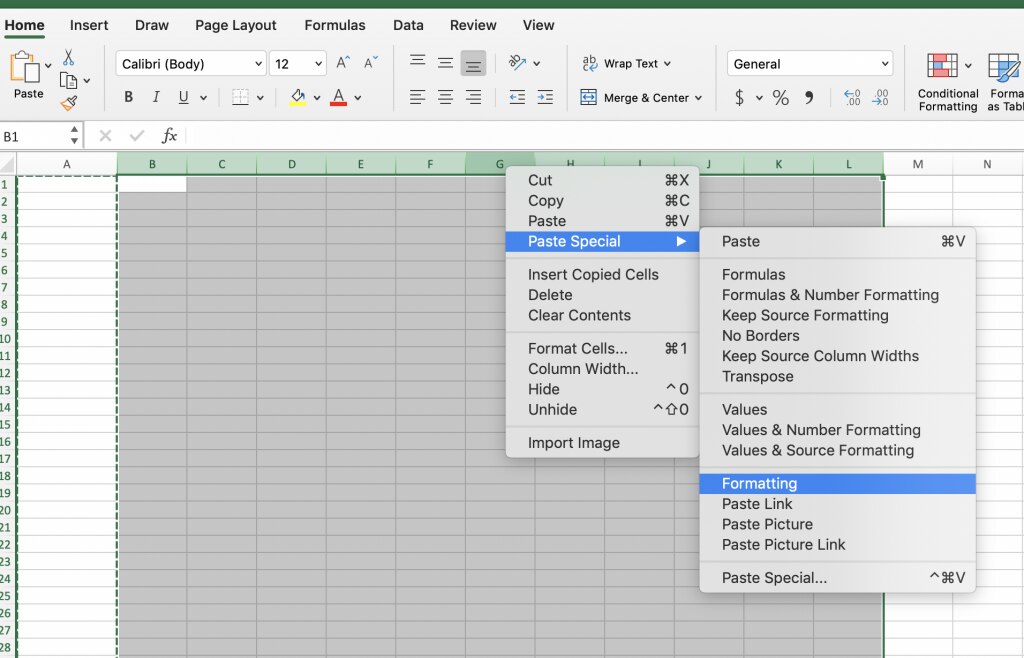
Step 2: Title your timesheet
Type the name of your business into cell A1. Centre the text by width and height, and format the text by font, size (we used size 38), and colour, then bold it. Highlight cells A1 through L1. Select Merge & Centre on the Home toolbar.
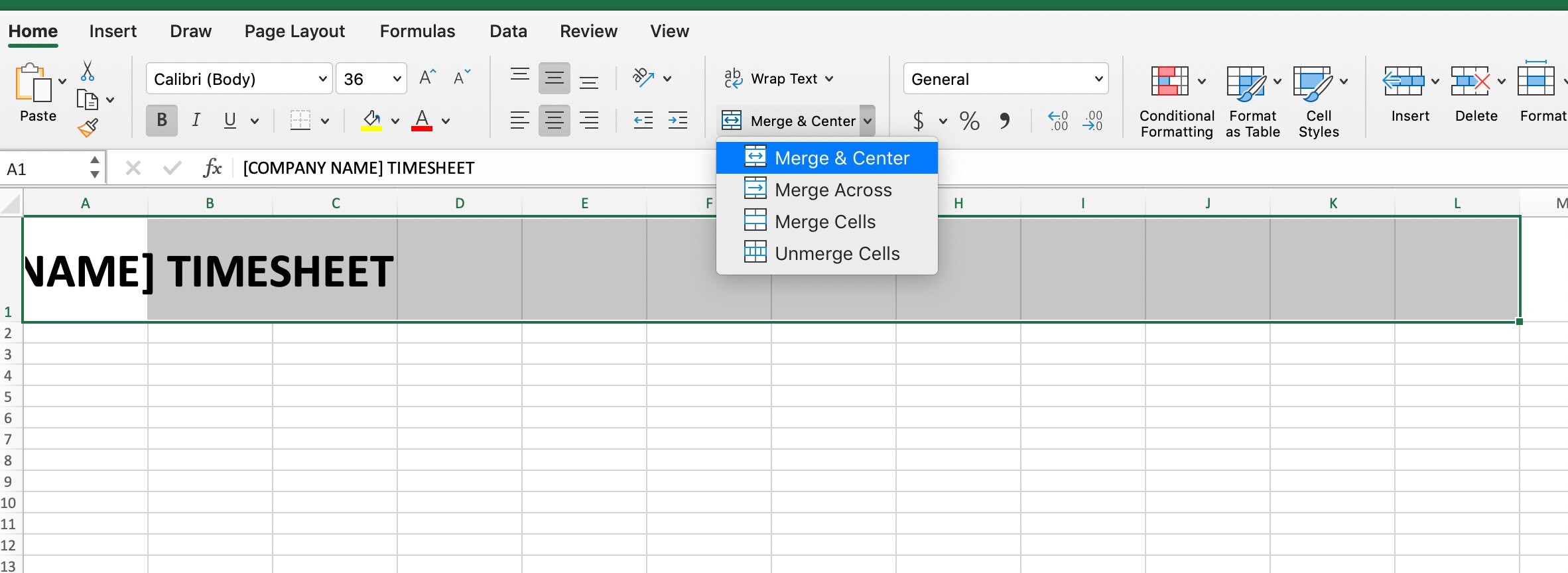
Step 3: Add labels to your timesheet
Add labels like EMPLOYEE and MANAGER (with signature and date lines for each), THIS WEEK’S START DATE, STANDARD PAY RATE, and OVERTIME PAY RATE. We used cells A2, A4, F2, F4, K2, K4, E6, H6, and K6.
For THIS WEEK’S START DATE, STANDARD PAY RATE, and OVERTIME PAY RATE, select Wrap Text, so the words don’t take up more than one cell.
In the cells following each label, make a line for employees and managers to write or type over by merging the cells and then applying a Bottom Border (from the borders tool, located on the Home toolbar). Merge cells A7 through L7 to create a small barrier between the next set of labels.
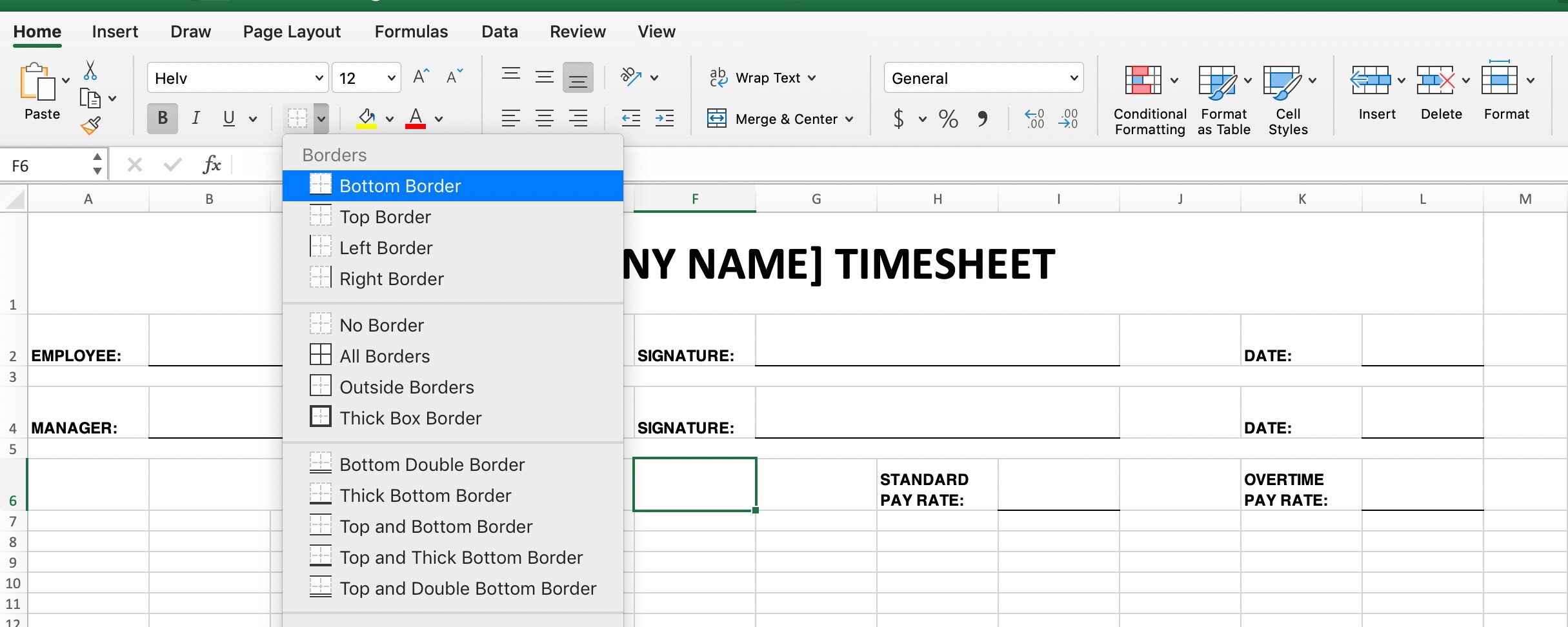
Step 4: Add timesheet labels
In row 8, create labels for each column: DAY, DATE, JOB/SHIFT, TIME IN, TIME OUT, TIME IN, TIME OUT, TOTAL (HOURS), OVERTIME (HOURS), SICK (HOURS), HOLIDAY (HOURS), and HOLIDAY (HOURS). TIME IN and TIME OUT are listed twice to account for lunch breaks.
Fill the row with any colour of your choice, and use the borders tool to put boxes around the column labels. Centre and bold the text.
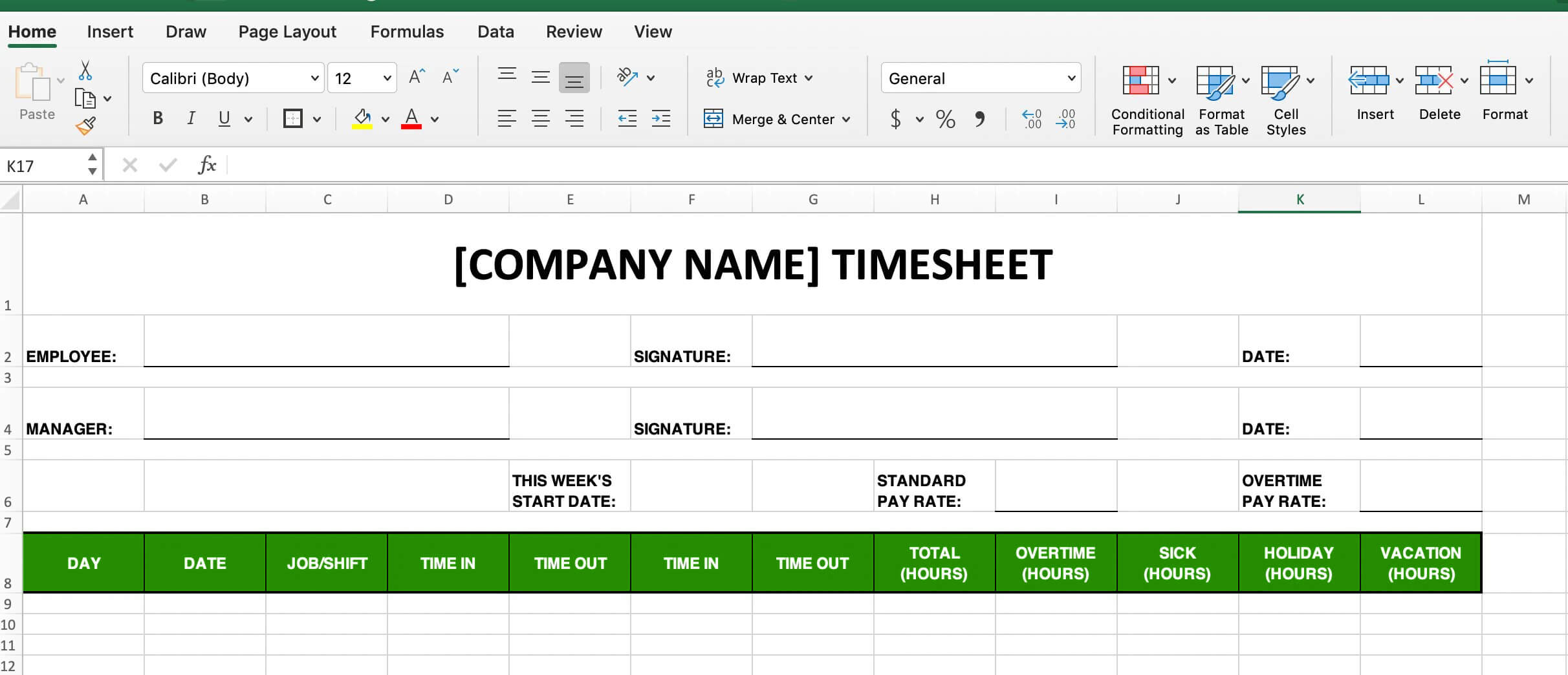
For this weekly timesheet, we’ve labelled the cells below DAY with the days of the week, each representing 24 hours during which a team member may work, starting with Monday in cell A9 and ending with Sunday in cell A15. Centre the labels up and down and side to side. Then widen rows 8 through 19 for better readability. Our rows are all about 46.00 high. Apply borders to all cells beneath the row of labels. Then add Thick Box Borders to better divide the table.

Step 5: Print the timesheet
If your plan is to print this template and have employees turn in handwritten timesheet data, you’re almost done!
The last thing you need to do is set up labels for totals. In cells G16, G17, and G18, write HOURS THIS WEEK, RATE, and SUB-TOTAL. In cell K19, write TOTAL. Make these cells whatever colour you like, then centre and bold the text. Use the borders tool to make these sections stand out.
Put some final spit and polish on your document by removing any unnecessary gridlines. Select View and uncheck the box that says Gridlines.Now you can print copies of this Excel timesheet for employee use.
- Highlight everything you want printed (A1 across to L1 and down to row 19).
- Click on File > Print > Show Details.
- Select landscape orientation.
- Under Print, choose Selection.
- Under Margins, choose Wide Margins.
- Check the box that says Scale to fit and click Print.
That’s it—you’re done! Don’t want to print? Keep reading.
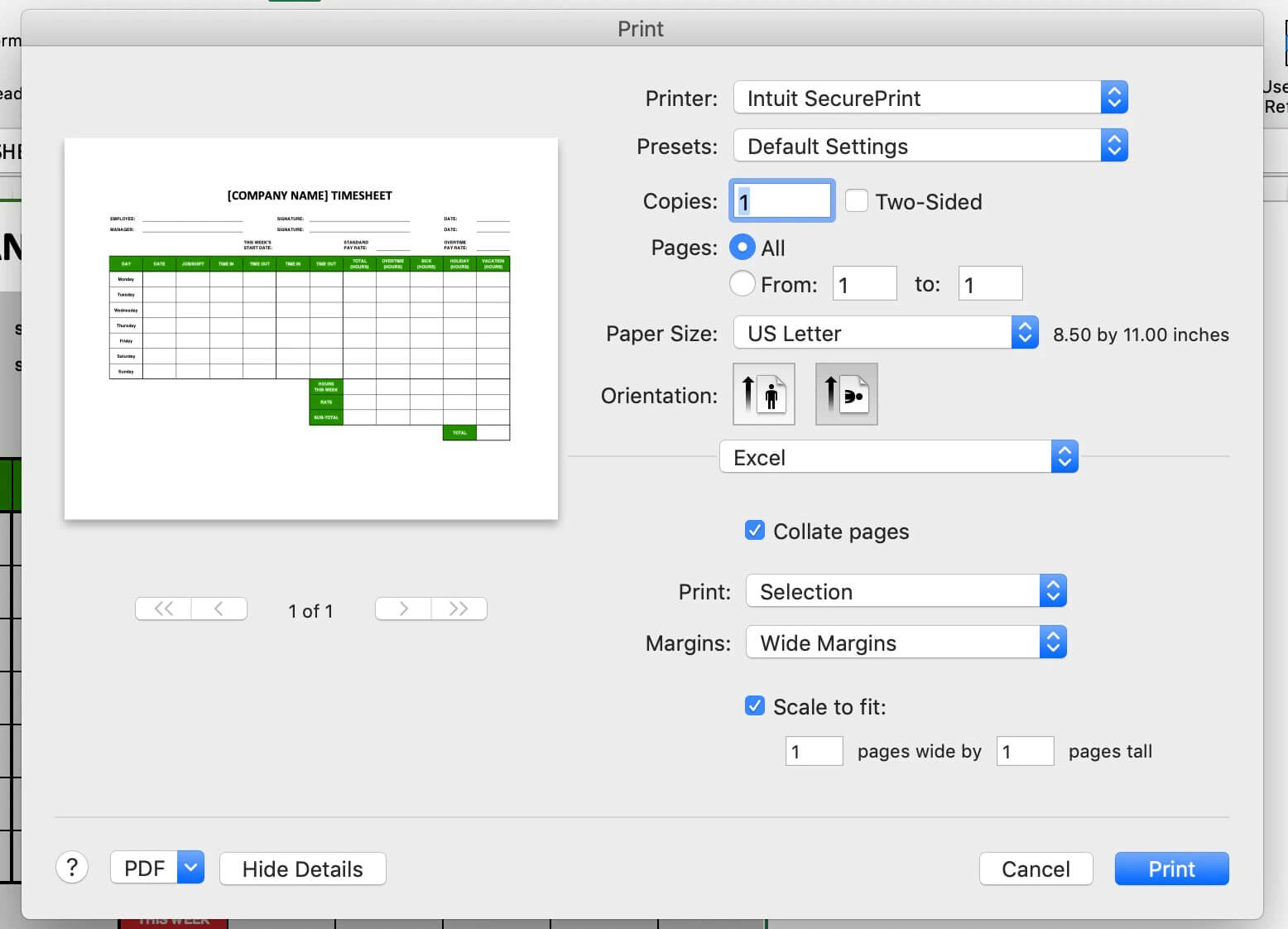
How to add formulas for automatic calculations
This is where we start making spreadsheet magic. Assuming you haven’t removed or added any days to your spreadsheet, HOURS THIS WEEK should be in cell G16, while TOTAL should be in cell K19.
Step 1: Prepare to add formulas for digital use
Follow instructions from step 5, then highlight cells H16 over L16 and down to row 18. Turn these and cell L19 grey. Now the boxes with your calculations will stand out from the rest of the employee’s timesheet entrees.
Step 2: Click on cell H16 or whatever cell is directly beside the box that says HOURS THIS WEEK. In the formula bar, type in =SUM(H9:H15) and press Enter. This box will now add any numbers entered in the column labelled TOTAL (HOURS).
Step 3: Click on cell I16. In the formula bar, type in =SUM(I9:I15) and press Enter. This box will now add any numbers entered in the column labelled OVERTIME (HOURS).
Step 4: Click on cell J16. In the formula bar, type in =SUM(J9:J15) and press Enter. This box will now add any numbers entered in the column labelled SICK (HOURS).
Step 5: Click on cell K16. In the formula bar, type in =SUM(K9:K15) and press Enter. This box will now add any numbers entered in the column labelled HOLIDAY (HOURS).
Step 6: Click on cell L16. In the formula bar, type in =SUM(L9:L15) and press Enter. This box will now add any numbers entered in the column labelled HOLIDAY (HOURS).
Step 7: In cell H17 (or whatever cell is directly beside RATE), type in the employee’s hourly rate. In the cell beside that, type in the employee’s overtime rate.
If your business provides paid time off (PTO) for sick time, holidays, and holidays, fill J17, K17, and L17 with the employee’s standard hourly rate.
As an example, if your employee makes $10 per hour, the bottom of your spreadsheet will look like this:
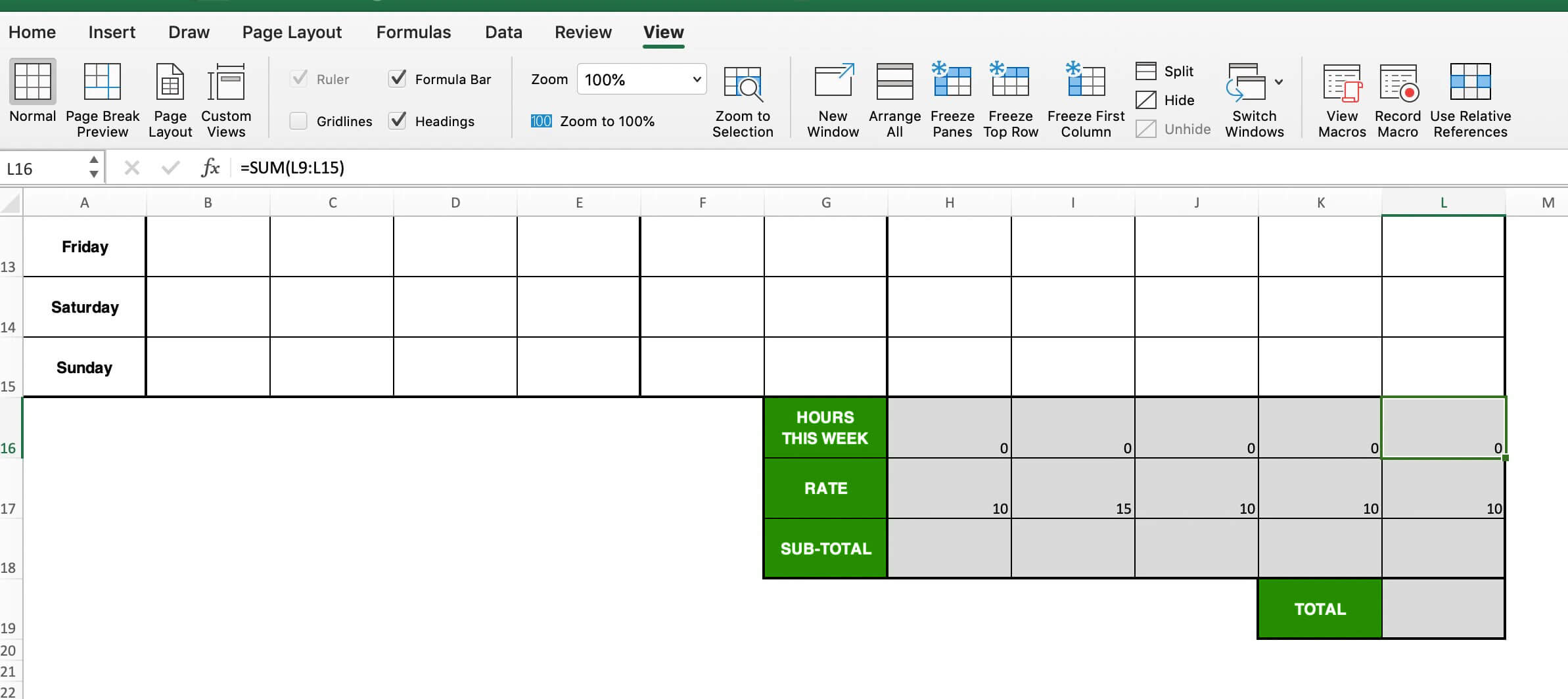
Step 8: Now to calculate subtotals. Click on cell H18 (or whatever cell is directly beside SUB-TOTAL). In the formula bar, type in =SUM(H16*H17) and press Enter. This box will now multiply the total hours an employee works by their standard pay rate to show how much money they’re owed.*
Step 9: Click on cell I18. In the formula bar, type in =SUM(I16*I17) and press Enter. This box will now multiply the employee’s overtime hours by their overtime pay rate to show how much they’re owed.*
Step 10: Click on cell J18. In the formula bar, type in =SUM(J16*J17) and press Enter. This box will now multiply the employee’s paid sick hours by their standard pay rate to show how much money they’re owed.*
Step 11: Click on cell K18. In the formula bar, type in =SUM(K16*K17) and press Enter. This box will now multiply the employee’s paid holiday hours by their standard pay rate to show how much money they’re owed.*
Step 12: Click on cell L18. In the formula bar, type in =SUM(L16*L17) and press Enter. This box will multiply the employee’s paid holiday hours by their standard pay rate to show how much money they’re owed.*
For example, say an employee worked 42 hours this week. Cell H16 should now say 40, while cell I16 should say 2. If your formulas are correct. H18 will say 400, while I18 will say 30.
*These are basic calculations and do not include things like taxes, workman’s comp, or other payroll payment deductions.
Step 13: At last, we get to calculate total money owed. Select cell L19. In the formula bar, type in =SUM(H18:L18) and press Enter. This box will now add the five sub-totals to show how much money your employee has made total (before bonuses, taxes, or other deductions).
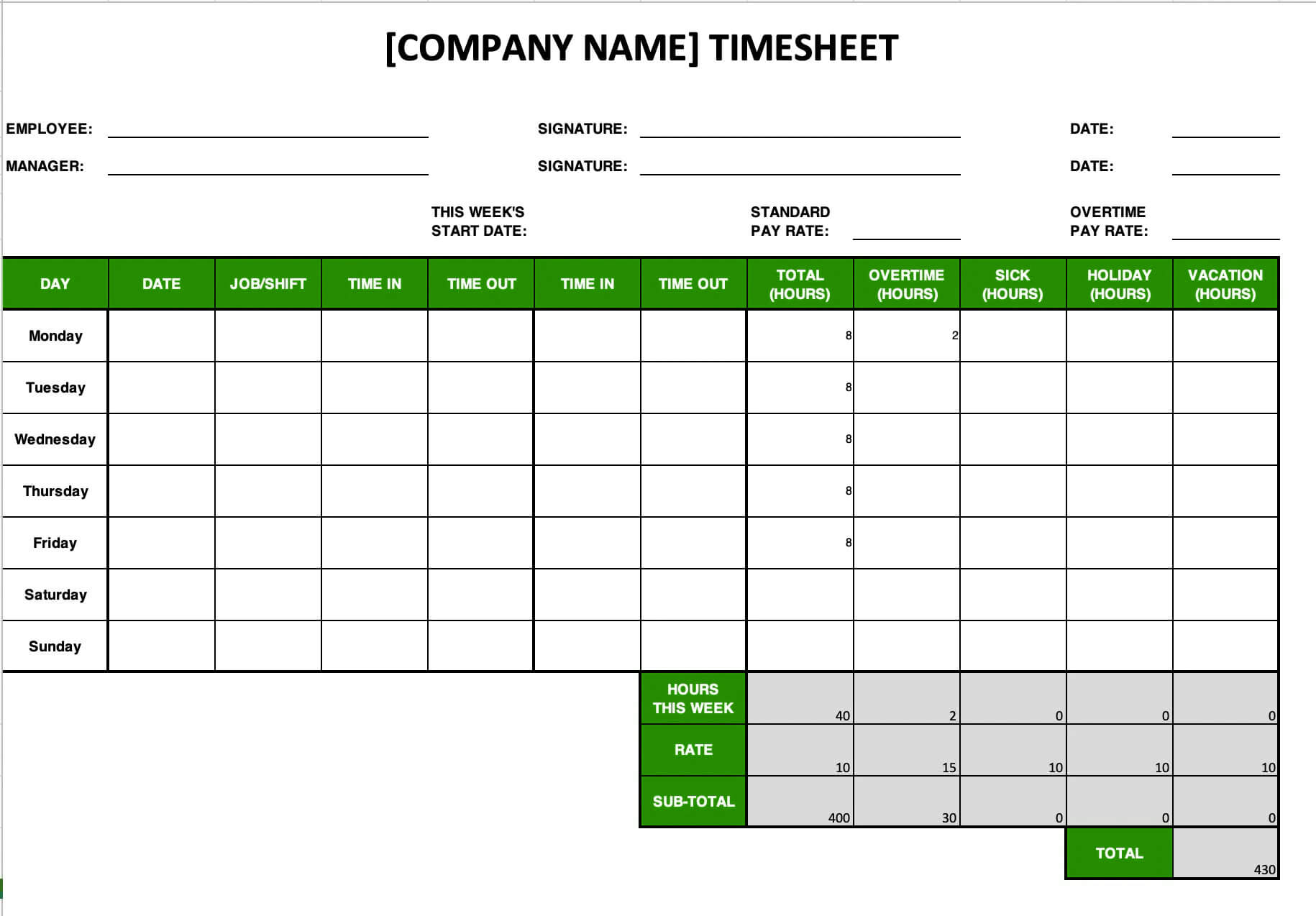
Free timesheet templates for download
Timesheet templates are for tracking employee time. Each template is printable but optimised for Excel. If your business needs a timesheet template with employee hours, overtime, holiday days, and even lunch breaks all included, this is a great solution.
Daily timesheet templates
The daily timesheet includes space for overtime hours, holiday time, lunch breaks, and more. It’s ideal for hourly temporary, part-time, or full-time workers who track time at one or more job sites and submit time daily. Download a template for workers each day for your time tracking and payroll records.
Weekly timesheet templates
The weekly timesheet includes space for overtime hours, holiday time, lunch breaks, and more. It’s ideal for hourly and salaried, full- and part-time employees who need to track time and submit timesheets for payroll weekly. The weekly timesheet has a line for every day of the week, ideal for workers who track time for one shift per day. Download a template for each worker, each week, for your time tracking and payroll records.
Monthly timesheet templates
The monthly timesheet includes space for overtime hours, holiday time, lunch breaks, and more. Hourly and salaried employees, either full- or part-time, who need to track time and submit timesheets for payroll monthly, can use the monthly timesheet. The monthly timesheet has space for 31 time entries, ideal for workers who track time for one shift per day. Download a template for each worker, each month, for your time tracking and payroll records.
Industry-specific timesheet templates
New construction templates
Download this PDF template to track time for construction workers. This weekly timesheet includes space for the worker’s name and ID number (if applicable), the worker’s trade classification, and their manager’s name. The template also includes space for the company name, location or project, job or activity, and the worker’s pay rate and hours worked. This template does not calculate the worker’s deductions, withholdings, or net wages paid. The template has enough space for seven entries (one per day) or many entries per day. Finally, PDFs are read-only. Print the template for the best results.
New volunteer templates
Download this PDF template to track time for volunteers. This weekly timesheet includes space for the volunteer’s name, their supervisor’s name, the organisation’s name, and the event or program they’re working for. Use this template to record the hours and overtime your volunteers work. This template doesn’t include space for sick, holiday, or holiday hours. This template has enough space for seven entries (one per day) or many entries per day. Finally, PDFs are read-only. Print the template for the best results.
New hospitality templates
Download this PDF template to track time for hospitality workers. This weekly template includes space for the worker’s name, plus their job or shift, pay rate, regular and overtime hours worked, and the worker’s site name or location. This template does not include calculations for the worker’s deductions, withholdings, or net wages paid. This template has enough space for seven entries (one per day) or many entries per day. Finally, PDFs are read-only. Print the template for the best results.



